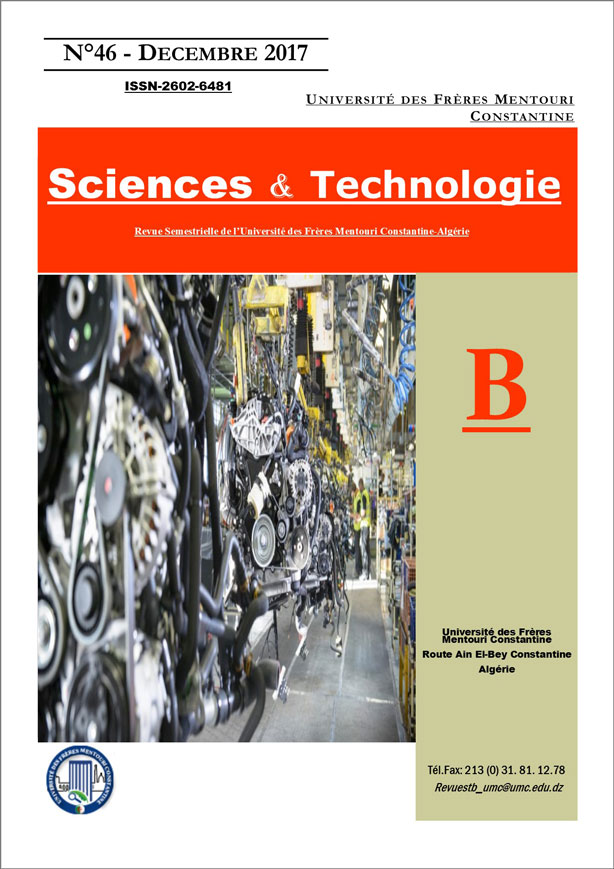OPTIMIZATION OF UNIQUAC INTERACTION PARAMETERS FOR ABSORPTION REFRIGERATION MACHINE WORKING FLUIDS.
Keywords:
UNIQUAC, UNIFAC, Excess enthalpy, Refrigerant, AbsorbentAbstract
To be able to pre-select new working fluids for absorption refrigeration systems, it is necessary to have a good understanding in the calculation or correlation of thermophysical properties of working fluids. The choice of the most appropriate thermodynamic model for the prediction or calculation of thermodysical properties is a crucial task. Consequently the present study deals with the determination of excess properties for refrigerant mixtures which are required for the calculation of the various involved enthalpies and hence the used refrigeration machine.
The present study considered the pairs (2-chloro-1,1,1,2-tétrafluoroethane) (R124) as a refrigerant in combination with an organic absorbent (N, N’- Dimethylacetamide) DMAC and (1,1,1,2-tetrafluoroethane) (R134a) as a refrigerant in combination with an organic absorbent dimethylether tetraethyleneglycol (DMETEG) by calculating the molecular interaction parameters for the UNIQUAC model using the excess enthalpy of mixing at eight different temperatures varying from 0°C to 140°C by a step of 20°C for the first pair and varying from 20°C to 140°C for the second pair.
The obtained interaction parameters values led to mixing excess enthalpy results very close to experimental values, contrary to the UNIFAC model which showed huge deviations. Therefore the optimization technique based on the Simplex method proved to be very reliable in the determination of interaction parameters for the UNIQUAC model.
References
I. Borde, M. Jelinek et N. C. Dalptrophe. "Working fluids for an absorption system based on R124 (2-chloro-1, 1, 1, 2, tetrafluoroethane) and organic absorbents".Int. J. Refrig. Vol. 20. N° 4. pp. 256-266. 1997
I. Borde, M. Jelinek et N. C. Dalptrophe. "Absorption system based on the refrigerant R134a".Int. J. Refrig. Vol.18.N° 6.pp.387-394. 1995
Louaer, A.-H. Meniai, O. Larkeche and M. Bencheikh-Lehocine, ‘Computer-aided design and test of new refrigerants for absorption cycle using group contribution methods’, Desalination Journal 206 (2007) 620-632, Elsevier
Fredenslund A., Jones R.L., Prausnitz J.M., 1975, Group-contribution estimation of activity coefficients in nonideal liquid mixtures, AIChE J., 21, 1086-1099
Maurer G., Prausnitz J.M., ”On the derivation and extension of the UNIQUAC equation”, Fluid Phase Equilibria, 2(1978)91-99
R. C. Reid, J. M. Prausnitz, B. E. Poling. "The properties of gases and liquids" , 4th Edition Mc Graw Hill Book Company, 1987.
H Nelder J. A., Mead R. A., 1965, Simplex method for function minimization, Comput. J., 7, 308-13.
I. Louaer, ‘Conception et test de nouveaux réfrigérants pour une machine frigorifique à cycle d’absorption utilisant la méthode de contribution de groupes’, Thése de Magistère, soutenue en 2004, université Constantine, Algeria
R. Jadot, G. Jumet, ‘Equilibre liquide-vapeur de mélanges d’éthers fluorés’, in High temperatures-High pressures, vol. 26, 1994.
M. Hifni, ‘Themodynamic study on absorption refrigeration systems using ammonia/ionic liquid working pairs’, Doctoral thesis defended in 2016, Rovira I Virgili, Spain.
R. Deng, X. jing, D.Zheng, X.Li’Vapor-liquid equilibrium measurements and assesments of fluoroethane+dimethyether diethylene glycol systems for the hybrid refrigeration cycle’ International Jounal of Refrigeration 43 (2014),176-186, Elsevier.
P. Srikhirin, S.Aphornratana, S.Chungpaibulpatana’A review of absorption refrigeration tecnologies’ Renewable and Sustainable Energy Reviews 5 (2001), 343-372, Elsevier. .
K. Mehrdad, P.Kiyan, At. Ugur ‘overview of ionic liquids used as working fluids in absorption cycles’(2013) Adv. Mech. Eng. Article ID 620592, 7 pages.
J.Sun, SG. Zhang ‘A review of working fluids of absorption cycles’ Renewable and Sustainable Energy 16 (2012), 1899-1906.
BJ. Eisman ‘Why refrigerant 22 should be favored for absorption refrigeration’ ASHREA J 12 (1959), 45-50.
M. Jelinek, A. Levy, I. Bord’ Density of binary mixtures from equilibrium measurements’ International Jounal of Refrigeration 30 (2008), 471-481.
X. Li, R. Zheng, D.X. Shen, Y.S. Meng, X.L. Li, B.Y’ Vapor –liquid equilibriaofdifluoromethane+N,N-dimethylacetamide, difluoromethane+dimethylether diethylene glycol and 1,1-difluoroethane+dimethylether diethylene glycol systems’ Fluid Phase Equilib 347 (2013), 15-21.
H. Perez-Blanco’ Absorption heat pump performance for different types of solution’International Jounal of Refrigeration 7(1984), 115-122.
RA. Marcriss, JM. Gutraj, TS. Zawacki’ Absorption fluid data survey’Inst.Gas Tech (1988), final report on world wide data.
X.H. Han, Z.J. Gao, Y.J. Xu’ Solubility of refrigerant1,1,1,2-tetrafluoroethane in the N,N-dimethyl formamide in the temperature range from (263.15 to 363.15) K. J. Chem.Eng.Data 56(2011), 1821-1826.
X.L. Meng, D.X. Zheng, X.R. Li,Y.S. Shen,’isotermal vapor liquid equilibrium measurements of 1,1-difluoroethane+N,N-dimethylformamide and N,N-dimethylacetamide’ J.Chem.Enj.data 58(2013a), 1078-1085.
X.L. Meng, D.X.Zheng, J.Z. Wang, X.R. Li’ Energy saving mechanism analysis of the absorption-compression hybrid refrigeration cycle’ Renew.Energy 57(2013b), 43-50.
Downloads
Published
How to Cite
Issue
Section
License
Les auteurs publiant dans cette revue acceptent les termes suivants :- Les auteurs détiennent le droit d'auteurs et accordent à la revue
le droit de première publication, avec l’ouvrage disponible simultanément [SPÉCIFIER LA PÉRIODE DE TEMPS] après publication, sous la licence Licence d’attribution Creative Commons qui permet à d'autres de partager l'ouvrage en en reconnaissant la paternité et la publication initiale dans cette revue. - Les auteurs peuvent conclure des ententes contractuelles additionnelles et séparées pour la diffusion non exclusive de la version imprimée de l'ouvrage par la revue (par ex., le dépôt institutionnel ou la publication dans un livre), accompagné d'une mention reconnaissant sa publication initiale dans cette revue.
- Les auteurs ont le droit et sont encouragés à publier leur ouvrage en ligne (par ex., dans un dépôt institutionnel ou sur le site Web d'une institution) avant et pendant le processus de soumission, car cela peut mener à des échanges fructueux ainsi qu'à un nombre plus important, plus rapidement, de références à l’ouvrage publié (Consulter The Effect of Open Access).


